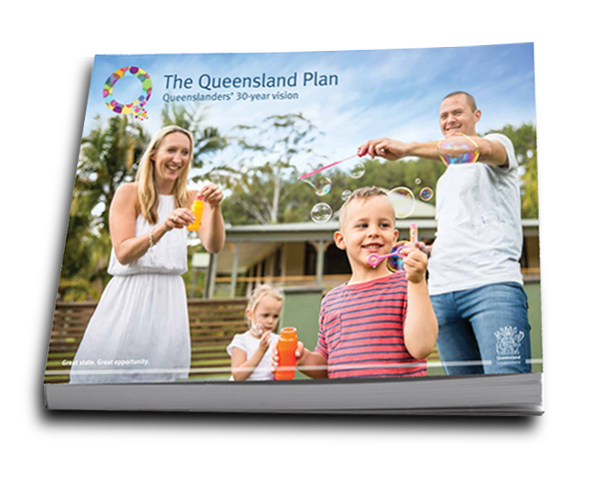Education
On this page:
- Queenslanders’ vision for education
- Why education is a foundation
- Spotlight on our education
- What Queenslanders want
- Achieving success
- Get involved
Queenslanders’ vision for education
In 2044, all Queenslanders will actively engage in and value education. We will have access to a quality education. Our teachers will be respected and, with their help, we’ll get the basics right in reading, writing and maths. We’ll also be high achievers in a range of areas, including science, engineering, technology and the arts. We’ll continue to learn and grow, motivated by the quality of our learning places. Our education will be practical and give us skills for jobs of the future. It will enable us to be inventive and productive, and connect us to experts and new industries. Everyone will have a go and aim to reach their full potential. Education will unite our community and enrich our lives.
Why education is a foundation
Queenslanders believe a quality education system is the launch pad for a rewarding life, meaningful career and innovative knowledge economy. Read more on page 19 of The Queensland Plan.
Spotlight on our education

What Queenslanders want
The following goals highlight what Queenslanders said they wanted to be, do or achieve (in relation to this foundation). These goals are accompanied by the outcomes Queenslanders said they want to see. Read detailed descriptions of success factors in The Queensland Plan.
| Goal | What does success look like? |
|---|---|
G1 |
The curriculum is responsive and focused on literacy and numeracy. |
| The majority of students have Asian language skills. | |
| The curriculum prepares a skilled workforce for tomorrow’s jobs. | |
G2 |
There is greater emphasis on learning outside the classroom. |
| Students are equipped with everyday life skills. | |
G3 |
The teaching profession is held in high esteem. |
| Teachers have attractive working conditions. | |
G4 |
Schools are hubs of learning, providing affordable and accessible education to all.* |
| Our education model leverages community/industry expertise through partnerships.* | |
| All Queenslanders can achieve their full education potential. |
*A top 10 priority identified by delegates at the Brisbane Summit.
^ Teachers include all types of educations, such as early childhood teachers, school teachers, university lecturers, tutors, and training instructors.
Achieving success
The following targets and measures will help focus our efforts towards achieving success. The baselines have been sourced from existing data sets as a starting point for future reporting. Download The Queensland Plan for a detailed explanation of what the measures show.
T1 Literacy and numeracy
100 per cent of Queensland children have basic literacy and numeracy in primary school.#
T2 Skills for life
All Queenslanders enter adulthood with life skills and broad knowledge.
T3 Valuing of education
Education is highly valued by all Queenslanders.
# Students with a language background other than English, who arrived from overseas less than a year before the tests, and students with significant intellectual disabilities or co-existing conditions may be exempted from NAPLAN testing.
| Primary measure | Starting point or baseline | ||||||||||||
|---|---|---|---|---|---|---|---|---|---|---|---|---|---|
Literacy and numeracyThe proportion of Year 3 and 5 students at or above the National Minimum Standard (NMS) for reading and numeracy. Source: Australian Curriculum, Assessment and Reporting Authority (2013), NAPLAN Achievement in Reading, Persuasive Writing, Language Conventions and Numeracy: National Report for 2013.
|
Baseline: Percentage of students at or above the NMS on NAPLAN, 2013. |
||||||||||||
School attendanceQueensland school attendance rates for Indigenous and non-Indigenous students. Source: Queensland Government State Schools Division (2013), Student Attendance 2009-2013.
|
Baseline: Attendance rates for Years 1–10 in Queensland state schools, Semester 1, 2013. |
||||||||||||
Valuing educationPercentage of Queenslanders who nominate education as one of their top values in state survey. Source: State survey.
|
Baseline to be created for 2014–15 through a state survey. |
||||||||||||
Participation in formal and non-formal learningSource: ABS 4234.0 (2013), Survey of Work-Related Training and Adult Learning.
|
Baseline: Percentage of Queensland |
||||||||||||
| Secondary measure | Starting point or baseline | ||||||||||
|---|---|---|---|---|---|---|---|---|---|---|---|
STEAM participationRates of participation in STEAM (science, technology, engineering, arts and mathematics) subjects. Source: Australian Government Department of Industry (2012), 2012 Higher Education Statistics for 2012.
|
Baseline: Students commencing studies at Queensland universities enrolled in STEAM subjects, 2012. |
||||||||||
Preschool educationProportion of children enrolled in a kindergarten (preschool) program. Source: ABS 4240.0 (2014), Preschool Education, Australia – derived by Department of Education, Training and Employment.
|
Baseline: All eligible Queensland children enrolled in pre-school and eligible Aboriginal and Torres Strait Islander Queensland children enrolled in pre-school, 2013. |
||||||||||
Post-school qualificationsPercentage of Queenslanders with a Certificate III or higher post-school qualification. Source: ABS Census of Population and Housing, 2011.
|
Baseline: Percentage of Queenslanders with Certificate III or higher post-school qualification, 2013. |
||||||||||
Education outcomesPercentage of students who, six months after completing Year 12, are participating in education, training and employment. Source: Queensland Government Department of Education, Training and Employment (2013), Next Step: A report on the destinations of Year 12 completers from 2012 in Queensland.
|
87.5% of Year 12 graduates. Baseline: Year 12 graduates participating in education, employment or training within six months of graduating, 2012. |
||||||||||
Occupational prestige/esteem of teaching professionPercentage of Queenslanders who esteem and have regard for Queensland teachers. Source: State survey.
|
Baseline to be created for 2014–15 through a state survey. |
Return to the foundations landing page to understand the purpose of the targets and measures or to select another foundation area to learn about.
Get involved
There are many ways you can help achieve our vision. Visit our Get involved page to read a few suggestions related to each foundation area.




